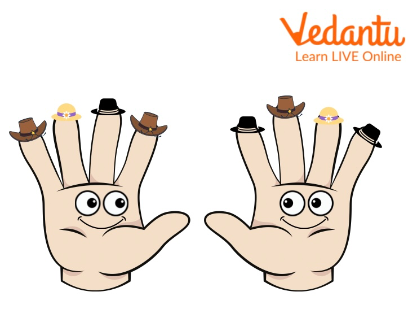This song is an action song; children will love to enact it with their hands. Also, this song helps children to get a basic understanding of their finger’s name. Key takeaways:
Learning the Thumbkin Song
Explanation of the rhyme.
The Action Song
In this song, children learn about each finger on their hands and their general purposes, by analogising their fingers to people and their hands to a family. It takes the form of a roll call similar to a classroom. The children learn to refer to their thumbs as Thumbkin; index fingers as Pointer; middle finger as Tallman; ring finger as Ringman, and little finger as Baby.
This acquaints children with their different fingers along with the social purposes for those fingers. Finally, it encourages children to be active with the dance for the rhyme requiring them to run away.

Where is Thumbkin?
Where is Thumbkin Lyrics
Where is the Thumbkin?
Where is the Thumbkin?
Here I am.
Here I am.
How are you today sir?
Very well I thank you.
Run away. Run away.
Where is the pointer? Where is the pointer?
Here I am.
Here I am.
How are you today sir?
Very well I thank you.
Run away. Run away.
Where is tallman? Where is tallman?
Here I am.
Here I am.
How are you today sir?
Very well I thank you.
Run away. Run away.
Where is ringman? Where is ringman?
Here I am.
Here I am.
How are you today sir?
Very well I thank you.
Run away. Run away.
Where is the baby? Where is the baby?
Here I am.
Here I am. How are you today sir?
Very well I thank you.
Run away. Run away.
Where’s the whole family? Where’s the whole family?
Here we are.
Here we are. How are you today sir?
Very well we thank you.
Run away. Run away.
Explanation of the Rhyme
Traditionally, parents and children can decorate the child's fingers to represent the characters too. After answering the roll call, the children run around in a circle before the stanza calling for the next finger is sung. This way, this action song becomes an interactive experience for the parent and is exciting for the child.
How Do We Have Fingers?
Evolution! We all know that humans have evolved from other mammals. If we look closely at most animals, we can see that their paws, feet, or hands have some finger formation, but it's not as clear as humans. Allowing for fingers meant that animals could push things and move them around. But, the next step of evolution, which is also visible in monkeys, came with opposable thumbs. This allows us to hold and grab things. It lets us write and open jars and peel bananas, for example.
Tips to Parents
Where is Thumbkin song is an exemplary finger play that is not difficult to instruct and get the hang of, making it ideal for infants and extremely youthful students. You can replace "Thumbkin" with a kid's name or your own. For considerably more tomfoolery, draw little faces on your fingers to make characters out of them!
As they are all part of a family, the child can associate each finger (thumb, index, middle, ring and little) as an individual and the collective group as a hand. It is also an excellent segue to introducing the concept of cooperation and teamwork to children. Parents may do this by identifying actions that fingers individually help with and by pointing out actions that a hand can do (writing, pushing a swing, holding an umbrella etc.).
Conclusion
Where is Thumbkin Mr Rogers song teaches about the number of fingers to the children in a fun way. It makes them aware of parts of their hands. It is also an interactive and engaging song that would excite children and acquaint them with the various roles of fingers. Further, it increases their mobility, as an action song requires children to move their bodies. The song is generally used to engage children (mostly pre-schoolers). It is also an excellent way for parents to bond with their children.


FAQs on The Where is Thumbkin Song
1. How many fingers do we have?
We have five fingers.
2. Who is the artist of this song?
The artist of the song is Frere Jacques.
3. What’s the shape of the finger?
The shape of the fingers is long and cylindrical.
This song is an action song; children will love to enact it with their hands. Also, this song helps children to get a basic understanding of their finger’s name. Key takeaways:
Learning the Thumbkin Song
Explanation of the rhyme.





